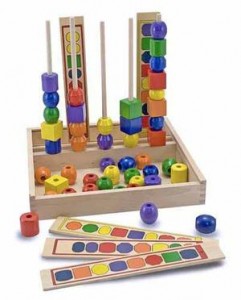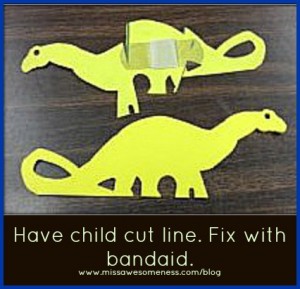imagination
How To Use A Single Toy To Work on Any Motor Skill
http://www.melissaanddoug.com/bead-sequencing-learning-set
I recently wrote Melissa and Doug (an amazing high quality brand that is in like every store you will ever walk into, except well, gas stations or something), and let them know I love their products but that they are missing a few pieces. For example, they often have great “extension activities” written on the back of their products that are developmentally awesome and clearly written by someone very skilled. Yet the average person won’t understand WHY these extension activities are helpful/useful, especially in regards to its applications to daily life skills. Many people think play is a waste of time and children are better off spending their time learning their academic skills. These people need education, because play is the number one way that children learn about their environment, and they need really strong foundational skills in their awareness of their own body and brain’s capabilities before they can truly apply it most successfully to the academic environment. All play toys can be used to work on academic skills and/or skills applicable to daily life interactions, with just some creative tweaking.
For example, I took this toy off their site at random and instantly spouted off the following ideas. Their website talks about how it works on matching, sequencing, and fine motor skills. Great, and I realize they don’t want to write a sixty page essay on its other uses. But I can. AHAHAHAAHAHA. It can be slightly modified – easily and without set-up – to work on many other types of skills. Gross motor, fine motor, sensory motor, ocular motor, visual motor…executive functioning skills, speech skills, general cognition, etc etc.
Any OT worth their salt (salts not worth that much these days though, so maybe worth their titanium), would be able to easily rattle off another six thousand trillion jillion zakillion more ideas within seconds. And I never exaggerate. Okay, one time I did. Like sixty years ago.
Cutting/fine motor manipulation/imagination: OT Activity
ACTIVITY
1. Take dinosaur post-it or other random animal paper. Child cuts across animal.
2. Child is veterinarian and fixes animal. (Skim over the fact we were directly responsible for its hurt, cough).
3. Give child a band-aid.
4. Child puts animal pieces together in right orientation, secures band-aid.
See below about grading the activity, skills worked on, and extra notes, while I figure out how to add in a “read more” link 🙂
TO GRADE ACTIVITY (change difficulty level) depending on child’s strengths/weaknesses:
Cutting:
Harder: Multiple lines, thinner lines, curvy or wiggled lines, lower contrast lines, more directions, having child make own lines first and cut out own.
Easier: One thick line, high contrast, fewer directions, no line at all, thicker paper (like a manila folder, construction paper, index card), modified scissors
Band-aid:
Harder:Child gets out band-aid and performs rest of task independently or with minimal assistance, no prompting for sequencing
Easier: Open the band-aid or help the process (start it until manageable by child, such as peeling the bandaid pieces a tiny bit apart and child takes over). Help hold the papers down so child can apply bandaid.
Imagination:
Harder: Do not give the child a sample, fewer prompts, encourage playing pretend
Easier: Role model playing pretend yourself only, give child sample
SKILLS worked on with animal band-aid activity:
- Cutting
- Fine motor manipulation (opening and placing bandaid)
- Visuospatial organization (placing pieces back together)
- Imagination/creativity/flexibility (understanding concept via drama/pretend/silliness)
- Life skill (manipulating band-aid)
- Cognition/Problem-solving (figuring out how to use the band-aid and put it all together)
Notes:
1. Be silly/dramatic. Children with mental rigidity can handle this sort of task as it’s concrete enough to make sense, but the imaginative creative piece is helped by silliness. “Oh nooooo our poor dinosaur!! I hope we can fix him!!!”
2. KIDS LOVE BANDAIDS. I didn’t have any cool ones, but that would help even more. If you have more than one type, let them choose. Even children resistant to cutting/directions may complete this task if they see a band-aid is involved!



